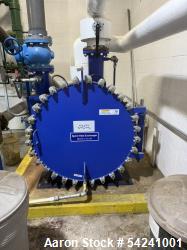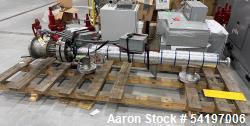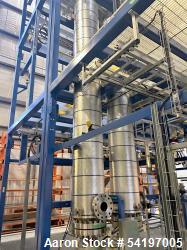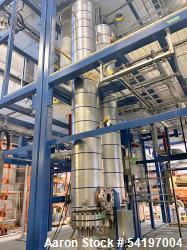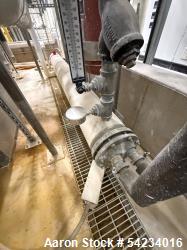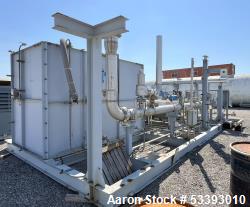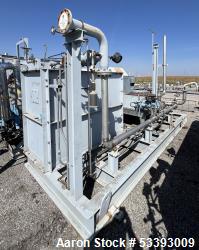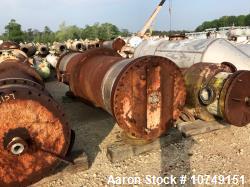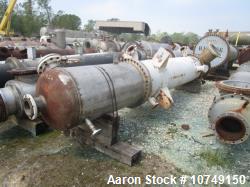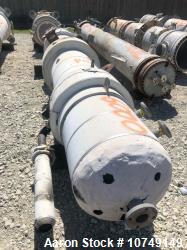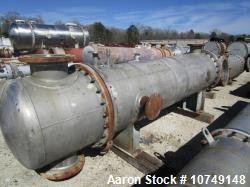Used Heat Exchangers
Aaron Equipment has a large inventory of reconditioned, unused, and used heat exchangers. Aaron's inventory of heat exchangers include air cooled, plate type, scraped surface, alloy shell & tube, carbon shell & tube, stainless shell & tube, and spiral heat exchangers. Heat exchangers are used in space heating, refrigeration, air conditioning, power plants, chemical, sewage treament and petroleum refineries. Heat exchangers are used to transfer heat between fluids for either a cooling or heating process. Its history began with the invention of the plate heat exchanger in 1923, and since then its design has dramatically evolved. There are several different types of heat exchangers, three of which include plate, shell and tube, and plate and shell. Purchasing used equipment is typically 40-50% cheaper than buying new and can save thousands of dollars. Buying used permits the purchaser to control the delivery date, often just a few weeks, whereas new equipment delivery can take months or even a year to manufacture. If you are looking to sell your used heat exchangers submit a request online or contact Erik Eichert at 630-238-7480.
Shells, Tubes and Plates: Everything a buyer should know about heat exchangers.
Heat exchangers play a pivotal role in various industrial and commercial applications. They are essential devices that transfer heat between two or more fluids, allowing efficient heating or cooling processes without mixing the fluids. This article will delve into the different types of heat exchangers, focusing on plate heat exchangers, shell and tube carbon exchangers, and shell and tube steel exchangers. Understanding these can help buyers make informed decisions when selecting the right heat exchanger for their needs.
Introduction to Heat Exchangers
Heat exchangers are used in many industries, from HVAC systems to chemical processing and power generation. They are designed to maximize the wall's surface area between two fluids while minimizing resistance to fluid flow. This ensures efficient heat transfer, crucial for energy conservation and process optimization in various systems.
Types of Heat Exchangers
- Plate Heat Exchangers consist of multiple thin, slightly separated plates with very large surface areas and fluid flow passages for heat transfer. They are known for their compact size and high efficiency.
- Advantages of Plate Heat Exchangers
- High Efficiency: The design allows for a large surface area, which leads to efficient heat transfer.
- Compact Size: Plate heat exchangers are smaller than shell and tube exchangers, making them ideal for space-constrained applications.
- Easy Maintenance: They can be easily disassembled for cleaning and maintenance.
- Applications of Plate Heat Exchangers
- Plate heat exchangers are commonly used in food processing, HVAC systems, and chemical processing plants where compact and efficient heat transfer is required.
- Plate heat exchangers are commonly used in food processing, HVAC systems, and chemical processing plants where compact and efficient heat transfer is required.
- Advantages of Plate Heat Exchangers
- Shell and Tube Heat Exchangers are composed of tubes, one set carrying the hot fluid and the other holding the cold fluid. The two tubes are enclosed in a shell, allowing heat transfer between the fluids.
- Shell and Tube Carbon Exchangers are made using carbon steel, which is known for its strength and durability. These exchangers are typically used in high-pressure and high-temperature applications.
- Advantages of Shell and Tube Carbon Exchangers
- Durability: Carbon steel provides excellent strength and can withstand high pressures and temperatures.
- Versatility: Suitable for a wide range of applications, including oil refineries and chemical processing.
- Cost-Effective: Generally, less expensive than stainless steel counterparts.
- Applications of Shell and Tube Carbon Exchangers
- These exchangers are frequently used in industries such as petroleum, chemical processing, and power generation, where durability and resistance to high pressure are critical.
- Advantages of Shell and Tube Carbon Exchangers
- Shell and Tube Steel Exchangers, often made from stainless steel, offer excellent corrosion resistance and are suitable for a variety of applications, especially where fluid purity and cleanliness are critical.
- Advantages of Shell and Tube Steel Exchangers
- Corrosion Resistance: Stainless steel resists rust and corrosion, making it ideal for long-term use.
- Hygienic: Preferred in industries where cleanliness is paramount, such as pharmaceuticals and food processing.
- Robustness: Able to handle a wide range of temperatures and pressures.
- Applications of Shell and Tube Steel Exchangers: These exchangers are commonly used in food processing, pharmaceuticals, and water treatment plants where corrosion resistance and hygiene are important.
- Advantages of Shell and Tube Steel Exchangers
Key Considerations for Buyers
When selecting a heat exchanger, buyers should consider several factors to ensure they choose the right type for their specific needs.
- Thermal Performance: The efficiency of a heat exchanger is critical. Consider the thermal performance required for your application and choose an exchanger that meets these needs without excessive energy consumption.
- Material Compatibility: Ensure the materials used in the heat exchanger are compatible with the fluids being processed. This is especially important in industries dealing with corrosive substances or extreme temperatures.
- Maintenance and Cleaning: Ease of maintenance is an important factor. Plate heat exchangers are easier to clean than shell and tube exchangers, but the latter might offer advantages in high-pressure applications.
- Cost: Evaluate the initial cost along with long-term operational costs. While some materials are more expensive upfront, they offer savings in maintenance and longevity.
Selecting the right heat exchanger is crucial for optimizing efficiency and longevity in any heating or cooling system. By understanding the differences between plate heat exchangers, shell and tube carbon exchangers, and shell and tube steel exchangers, buyers can make informed decisions that align with their operational requirements and budget constraints. Please remember to consider factors such as thermal performance, material compatibility, maintenance needs, and overall cost to make sure you choose the best solution for your application.
